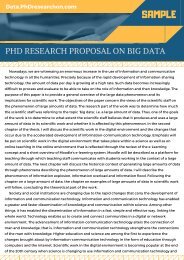PhD Research Proposal on Cloud Computing Sample
Hello! Today we prepared for you a useful phd research proposal on cloud computing sample. For more information go to http://it.phdresearchon.com/
Hello! Today we prepared for you a useful phd research proposal on cloud computing sample. For more information go to http://it.phdresearchon.com/
Create successful ePaper yourself
Turn your PDF publications into a flip-book with our unique Google optimized e-Paper software.
IT.<str<strong>on</strong>g>PhD</str<strong>on</strong>g>research<strong>on</strong>.com<br />
CLOUD COMPUTING<br />
<strong>Cloud</strong> computing is <strong>on</strong>e of the fastest growing IT trends. More and more users are turning to the way<br />
computer resources are used as a service, not as a product. Paying as needed is the main idea behind cloud<br />
computing. It is a pay-per-use model that provides easy and accessible access to computer resources groups<br />
over the Internet. At the basic level, cloud computing is a simple means of providing IT (Informati<strong>on</strong> Technology)<br />
resources as a service. By developing the Internet and increasing the transmissi<strong>on</strong> speed, it is possible to perform<br />
certain tasks remotely. Many companies are turning to business using cloud-based services and resources.<br />
Infrastructure, computer resources and applicati<strong>on</strong>s are relocated to service providers, and are charged as<br />
needed. The c<strong>on</strong>cept of cloud computing involves the use of a remote server network, rather than local servers<br />
and pers<strong>on</strong>al computers, for storing, managing, and processing data. The keyword in the name is the cloud.<br />
Because the places where the servers are located, where applicati<strong>on</strong>s are run and the data is stored, are not<br />
strictly defined, the term "in the cloud" is used. The first chapter will describe the "all as a service" model and will<br />
list the differences in the use of services based <strong>on</strong> cloud computing and cloud computing. The sec<strong>on</strong>d chapter<br />
will discuss the use of cloud applicati<strong>on</strong>s, the SaaS c<strong>on</strong>cept, while the third will discuss what kind of platform is<br />
in the cloud. The fourth and fifth chapters will provide the ec<strong>on</strong>omic, or technical advantages, for cloud-based<br />
services. Chapter six will provide examples of commercial computer clouds (global and local examples). <strong>Cloud</strong><br />
computing is developing as a model for all-as-a-service (XaaS) support. Virtualized physical resources,<br />
virtualized infrastructure, platforms and business applicati<strong>on</strong>s are secured and used as cloud services. Systems<br />
using the XaaS model require understanding and use of a number of development technologies as well as existing<br />
cloud computing services. Customers using traditi<strong>on</strong>al approaches meet all their needs for applicati<strong>on</strong>s and<br />
computing resources using the resources they own. Applies to applicati<strong>on</strong>s executed directly <strong>on</strong> their computer.<br />
C<strong>on</strong>trary to the traditi<strong>on</strong>al approach where all the user-owned resources are needed, the c<strong>on</strong>cept based <strong>on</strong><br />
computing in the cloud introduces models of n<strong>on</strong>-user resource usage [3]. Users can access informati<strong>on</strong> from<br />
providers, so they can also use applicati<strong>on</strong>s from that service provider; applicati<strong>on</strong>s in the cloud ie the SaaS<br />
applicati<strong>on</strong>. Users can develop or purchase and use applicati<strong>on</strong>s running <strong>on</strong> cloud platforms in some service<br />
providers. And finally, I can use the entire virtualized infrastructure. Software as a Service (SaaS) enables the use<br />
of cloud applicati<strong>on</strong>s. Manufacturer soluti<strong>on</strong>s builds an applicati<strong>on</strong>, manages the applicati<strong>on</strong> itself and the hosting<br />
envir<strong>on</strong>ment, and makes it available to users via the network. Most of people today actively uses <strong>on</strong>e of the SaaS<br />
services. The most important difference between the SaaS-based software and the traditi<strong>on</strong>al <strong>on</strong>e is that the<br />
software is not being purchased, but the service of its use is paid (Lenk et al.,, 2009). This allows us to pay for the<br />
software as much as we actually use it, and at any time to adjust the number of system users and the range of<br />
functi<strong>on</strong>s according to our needs or simply cancel the service when it no l<strong>on</strong>ger needs it. For SaaS services, <strong>on</strong>e<br />
copy of the service is used by several users. From the perspective of the service provider, such an approach can<br />
be a significant improvement, as it makes it easier to update, maintain, and generally work with the applicati<strong>on</strong>.<br />
Probably the most famous provider of various SaaS services is Google. Google offers Gmail, Google Groups,<br />
Google Calendar, Google Talk, Google Docs and Google Sites, and all of the services together make up Google<br />
Apps. SAP offers an Enterprise Resource Planning applicati<strong>on</strong>, abbreviated ERP, Bussiness ByDesign. IBM offers<br />
the Lotus applicati<strong>on</strong> for employee collaborati<strong>on</strong> within a company. NetSuite, which offers cloud-based cloudbased<br />
cloud based applicati<strong>on</strong>s, offers its own CRM, ERP and other services. Zoho offers a full range of cloud<br />
services: CRM, Mail, Docs, Meeting and many more. The <strong>Cloud</strong> Platform is a cloud computing format that is most<br />
suitable for companies and software developers. Allows you to create and execute applicati<strong>on</strong>s, store data, and
RESEARCH PROPOSAL ON CLOUD COMPUTING<br />
PHD<br />
IT.<str<strong>on</strong>g>PhD</str<strong>on</strong>g>research<strong>on</strong>.com<br />
network. Access to a virtual machine or storage space is most likely via a browser. It is possible to request<br />
resources for a specified period of time and return them back after the end of use. In the event of a need to<br />
increase resources over a short period of time, a large number of servers are <strong>on</strong>ly required in certain situati<strong>on</strong>s<br />
that it is very expensive to buy so many servers at first, as most of the time they do not work at full intensity. In<br />
the case of a cloud platform, it is possible to reserve a sufficient number of virtual machines for the increased<br />
number of requests in that period, and then quit and stop paying for them. It is <strong>on</strong>ly possible to collect those<br />
resources that are actually used in a given time period. One of the great advantages of the cloud platform is the<br />
shorter the time it takes from the applicati<strong>on</strong> to the beginning of use. Instead of a few days to a few weeks of<br />
waiting for a new physical server or a virtual machine in its own data center, a public cloud platform can be used<br />
to get a new virtual machine or other resources in a very short period of time. Financial risk is also reduced as<br />
there is no need for high initial investment. The need for own computer resources, such as servers and staff in the<br />
IT department, is diminished as more work is d<strong>on</strong>e in the public cloud. Upgrading and updating the system is not<br />
the resp<strong>on</strong>sibility of the company, but the resp<strong>on</strong>sibility lies with the service provider. One of the risks that the<br />
cloud platform brings is trust. <strong>Cloud</strong> platform users must trust the service provider to be available and secure.<br />
<strong>Cloud</strong> platforms naturally fit into start-up projects, as they provide easy access to computer resources in a<br />
modern data center for every<strong>on</strong>e. It's so simple and cheaper to try new things. If the project fails, it is not lost a lot<br />
of m<strong>on</strong>ey, if it succeeds, it's possible to react quickly and buy additi<strong>on</strong>al resources. Scalability of the applicati<strong>on</strong><br />
inside the cloud is painless and guaranteed. Also, companies can find applicati<strong>on</strong> platforms in the cloud in their<br />
everyday business, e.g. when they need additi<strong>on</strong>al computing resources. Infrastructure as a service provides data<br />
storage and computing capabilities as standardized services over the network. It enables the delivery of servers,<br />
network technology, data storage and space in the data center. Servers, storage systems, and so <strong>on</strong> are designed to<br />
handle a variety of workloads ranging from applicati<strong>on</strong> comp<strong>on</strong>ents to high-speed computers performance. A<br />
user who wants to develop an applicati<strong>on</strong> in the cloud using the IaaS service must have access to the virtual<br />
machines provided by the service provider. Suppose a user needs a database and a web server. It can select a<br />
virtual machine for the database that the applicati<strong>on</strong> will use and the virtual machines <strong>on</strong> which the applicati<strong>on</strong><br />
will run. In order to more effectively balance the load, i.e. the applicati<strong>on</strong> makes scalable it takes several virtual<br />
machines <strong>on</strong> which the applicati<strong>on</strong> will run and which c<strong>on</strong>tain some kind of web server. Once the virtual<br />
machines are selected, you need to create a database and fill in the data, and then install the applicati<strong>on</strong> <strong>on</strong> virtual<br />
machines and c<strong>on</strong>figure the distributed load. Any further administrati<strong>on</strong> and upgrade of virtual machines should<br />
be managed by the software developer. Unlike Infrastructure as a service, the platform as a service, PaaS, other<br />
than computer. The resource also includes a set of features / tools for developing, testing, and deploying software,<br />
as well as middleware. It can also offer applicati<strong>on</strong> services such as team collaborati<strong>on</strong>, database integrati<strong>on</strong>,<br />
security, scalability, storage, and more. If a user who wants to develop an applicati<strong>on</strong> in the cloud using PaaS has<br />
an existing platform that knows how to run applicati<strong>on</strong>s. Comparing the applicati<strong>on</strong> development with the IaaS<br />
service, users do not need to run virtual machines because the platform already exists. The burden of scheduling<br />
the load and updating the operating system <strong>on</strong> virtual machines is led by the service provider, not the user itself.<br />
The main difference between PaaS and IaaS is the level of c<strong>on</strong>trol over the system available to the service user<br />
(Armbrust et al., 2010). The IaaS service provides complete c<strong>on</strong>trol, while the PaaS service usually does not<br />
provide any c<strong>on</strong>trol or provides <strong>on</strong>ly scheduled c<strong>on</strong>trol. Applicati<strong>on</strong> development using the PaaS service is faster,<br />
cheaper, and less risky. Software developers are left with less work to do <strong>on</strong> their own. More work is left to the<br />
platform. However, PaaS can be easily used in less cases compared to IaaS. The PaaS service is an excellent<br />
soluti<strong>on</strong> in cases where the particular envir<strong>on</strong>ment is intended, but is not suitable for wide use, such as IaaS. As<br />
can be seen from the explanati<strong>on</strong> in the previous chapters, computer clouds are, in fact, a means by which<br />
computer resources can be offered to users in the form of public utility services, quite similar to the supply of<br />
electricity, water, gas or telecommunicati<strong>on</strong>s. In order to fully understand the c<strong>on</strong>ceptual advantages of<br />
computing in the cloud, it is necessary to menti<strong>on</strong> two main beneficial c<strong>on</strong>sequences of its definitive properties:
RESEARCH PROPOSAL ON CLOUD COMPUTING<br />
PHD<br />
IT.<str<strong>on</strong>g>PhD</str<strong>on</strong>g>research<strong>on</strong>.com<br />
elasticity and optimum procurement. Elasticity means that the use of computer resources can be precisely<br />
adjusted by the engagement of individual computers. Namely, most computers usually have a total yield between<br />
5% and 20% (Hurwitz et al., 2009). At the same time, the services that these computers provide can be (and most<br />
often are) such that they have peak (maximum) loads. When purchasing your own hardware, these loads must be<br />
taken into account. Therefore, the buyer is in the situati<strong>on</strong> that in ordinary times, when there are no peak loads,<br />
the purchased hardware is underused, which significantly increases the cost of the drive, expressed at the cost of<br />
the effective operating hours of the computer.<br />
References<br />
Lenk, A., Klems, M., Nimis, J., Tai, S., & Sandholm, T. (2009). What’s Inside the <strong>Cloud</strong>? An<br />
Architectural Map of the <strong>Cloud</strong> Landscape, Proceedings of the 2009 ICSE Workshop <strong>on</strong> Software<br />
Engineering Challenges of <strong>Cloud</strong> <strong>Computing</strong>, 23 - 31.<br />
Hurwitz, J., Bloor, R., Kaufman, M. & Halper, F. (2010). <strong>Cloud</strong> <strong>Computing</strong> For Dummies, Indiana,<br />
USA: Wiley Publishing Inc.<br />
Armbrust, M., Fox, A., Griffith, R., Joseph, A. D., Katz, R., K<strong>on</strong>winski, A., Lee, G., Patters<strong>on</strong>, D.,<br />
Rabkin, A., Stoica, I., Zaharia, M. A (2010). View of <strong>Cloud</strong> <strong>Computing</strong>. Communicati<strong>on</strong>s of the<br />
ACM, 53 (4), 50 - 58.





